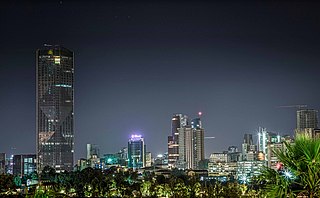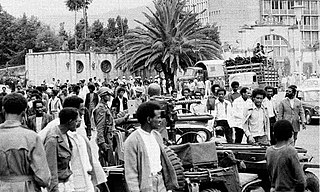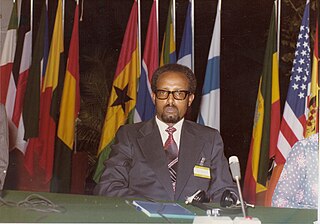
The economy of Ethiopia is a mixed and transition economy with a large public sector. The government of Ethiopia is in the process of privatizing many of the state-owned businesses and moving toward a market economy. The banking, telecommunication and transportation sectors of the economy are dominated by government-owned companies.

Addis Ababa is the capital and largest city of Ethiopia. In the 2007 census, the city's population was estimated to be 2,739,551 inhabitants. Addis Ababa is a highly developed and important cultural, artistic, financial and administrative centre of Ethiopia.

The government of Ethiopia is the federal government of Ethiopia. It is structured in a framework of a federal parliamentary republic, whereby the prime minister is the head of government. Executive power is exercised by the government. The prime minister is chosen by the lower chamber of the Federal Parliamentary Assembly. Federal legislative power is vested in both the government and the two chambers of parliament. The judiciary is more or less independent of the executive and the legislature. They are governed under the 1995 Constitution of Ethiopia. There is a bicameral parliament made of the 108-seat House of Federation and the 547-seat House of Peoples' Representatives. The House of Federation has members chosen by the regional councils to serve five-year terms. The House of Peoples' Representatives is elected by direct election, who in turn elect the president for a six-year term.

The People's Democratic Republic of Ethiopia was a socialist state that existed in Ethiopia and present-day Eritrea from 1987 to 1991.

The African Investment Bank (AIB) is one of three financial institutions of the African Union (AU) along with the African Monetary Fund and the African Central Bank. It will be headquartered in Tripoli, Libya.
The National Bank of Ethiopia is the central bank of Ethiopia. Its headquarters are in the capital city of Addis Ababa. Mamo Mihretu is the current governor of the bank.

The Commercial Bank of Ethiopia (CBE) is the largest commercial bank in Ethiopia. As of June 2021, it had about 1.1 trillion birr in assets and held approximately 67% of deposits and about 53% of all bank loans in the country. The bank has around more than 35,000 employees as of June 2022, who staff its headquarters and its over 1000+ branches positioned in the main cities and regional towns. The latter include 120 branches in the national capital Addis Ababa. With the opening of a branch in the Gechi in the Illubabor Zone, CBE's banking network has reached online 783 branches. The bank has reached more than 1950 branches as of 10 August 2022.

The Ethiopian Civil War was a civil war in Ethiopia and present-day Eritrea, fought between the Ethiopian military junta known as the Derg and Ethiopian-Eritrean anti-government rebels from 12 September 1974 to 28 May 1991.

Access to water supply and sanitation in Ethiopia is amongst the lowest in Sub-Saharan Africa and the entire world. While access has increased substantially with funding from foreign aid, much still remains to be done. Some factors inhibiting the achievement of these goals are the limited capacity of water bureaus in the country's nine regions, two city administrations and water desks in the 770 districts of Ethiopia (woredas); insufficient cost recovery for proper operation and maintenance; and different policies and procedures used by various donors, notwithstanding the Paris Declaration on Aid Effectiveness.

Agriculture in Ethiopia is the foundation of the country's economy, accounting for half of gross domestic product (GDP), 83.9% of exports, and 80% of total employment.
Manufacturing in Ethiopia was, before 1957, dominated by cottage and handicraft industries which met most of the population's needs for manufactured goods such as clothes, ceramics, machine tools, and leather goods. Various factors – including the lack of basic infrastructure, the dearth of private and public investment, and the lack of any consistent public policy aimed at promoting industrial development – contributed to the insignificance of manufacturing.
Between 1950 and 1960, the imperial government of Ethiopia enacted legislation and implemented a new policy to encourage foreign investment in the Ethiopian economy. This new policy provided investor benefits in the form of tax exemptions, remittances of foreign exchange, import and export duty relief, tax exemptions on dividends, and the provision of financing through the Ethiopian Investment Corporation and the Development Bank of Ethiopia. In addition, the government guaranteed protection to industrial enterprises by instituting high tariffs and by banning the importation of commodities that might adversely affect production of domestic goods. Protected items included sugar, textiles, furniture, and metal. The government also participated through direct investment in enterprises that had high capital costs, such as oil refineries and the paper and pulp, glass and bottle, tire, and cement industries. In 1963, with the Second Five-Year Plan under way, the government enacted Proclamation No. 51. The proclamation's objective was to consolidate other investment policies enacted up to that period, to extend benefits to Ethiopian investors, and to create an Investment Committee that would oversee investment programs. In 1966 the Ethiopian government enacted Proclamation No. 242, which elevated the Investment Committee's status as an advisory council to that of an authorized body empowered to make independent investment decisions. Thus, by the early 1970s, Ethiopia's industrialization policy included a range of fiscal incentives, direct government investment, and equity participation in private enterprises.
The trade unions of Ethiopia have a total membership of approximately 300,000. Over 203,000 are members of the Confederation of Ethiopian Trade Unions (CETU).
The China-Africa Development Fund, more commonly known as CAD Fund, is a China Government Guidance Fund solely funded by China Development Bank, a Chinese government policy bank. The aim of the fund is to stimulate investment in Africa by Chinese companies in power generation, transportation infrastructure, natural resources, manufacturing, and other sectors.

Teferra Wolde-Semait was an Ethiopian economist who has served as Minister of Finance, and chairman of the board of the National Bank of Ethiopia from 1977 to 1982.

Brazil–Ethiopia relations are the current and historical relations between Brazil and Ethiopia. Both nations are members of the Group of 77, BRICS and the United Nations.

Urbanization of Addis Ababa began in late 19th century in a site of Finfinne inhabited by various Oromo clans, and Emperor Menelik II formed permanent settlement for his army and nobles. In 1881, he transferred his capital to Entoto, a vicinity area of Addis Ababa, ultimately relocated in Addis Ababa in 1886; he along with his wife Empress Taytu Betul founded it after finding Entoto undesirable due to coldy climate location, and abundance of hot mineral springs believed to have health effects in Addis Ababa. In 1890s, Addis Ababa saw rapid population growth due to factors related to 1889–1892 famine and immigration to the area and mobilisation of traditional militias and other associated immigrants after the Battle of Adwa (1896).

Addis Ababa's economy is growing rapidly and become leading among cities in Ethiopia. Over the last two decades, the city shifted to development-oriented programmes and privatization. In late 1990s, the Office for Revision of Addis Ababa's Master Plan (ORAAMP) and National Urban Planning Institute (NUPI) were launched to analyze the economic status of the city. The city covered 29% of Ethiopia's GDP and 20% of national urban development as of 2022.

The banking sector of Ethiopia composed of the central bank, the National Bank of Ethiopia (NBE) and the state owned Development Bank of Ethiopia (DBE), along with other thirty private banks. By 2020, the NBE planned to increase the minimum capital for banks to operate to 2 billion birr and instructed all commercial banks to increase their capital. Foreign banks did not allow to provide service in Ethiopia, instead use medium term as the government of Prime Minister Abiy Ahmed pursued wide economic reforms.

The Bank of Abyssinia is a commercial bank and the oldest bank in Ethiopia. It was established in 1905 and inaugurated by Emperor Menelik II on 16 February 1906, becoming the modern bank of Ethiopia.














